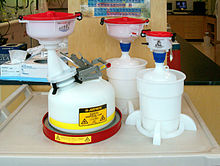Eco funnel
 From Wikipedia - Reading time: 5 min
From Wikipedia - Reading time: 5 min
This article has multiple issues. Please help improve it or discuss these issues on the talk page. (Learn how and when to remove these template messages)
|

An ECO Funnel, or a safety ecological funnel, is a funnel designed to safely handle hazardous liquid chemical waste and minimize environmental contamination, as well as help laboratories stay compliant with local health and safety codes.[1]
Origin[edit]

The ECO Funnel was conceptualized by Dr. Ron Najafi in 1996 during his tenure at a facility in the San Francisco Bay Area.[2] This facility encountered issues related to odorous fumes emanating from the laboratory, which prompted an investigation beyond the confines of the chemical waste storage area.
As a member of the company's Health and Safety Committee, Dr. Najafi conducted thorough tests to assess the emission levels from unsealed waste bottles positioned under a fume hood. Employing a method that involved monitoring the rapid reduction in waste bottle volume over a defined timeframe, he substantiated the substantial evaporation of potentially hazardous chemicals into the surrounding environment.
Once the source and severity of the situation had been confirmed, a need was recognized to improve standard practice for the safety of lab personnel and to bring laboratories into adherence to public safety protocols such as those outlined by the Occupational Safety & Health Administration (OSHA) or the US Environmental Protection Agency (EPA):
- 29 CFR 1910.1450: “Avoidance of routine exposure: develop and encourage safe habits; avoid unnecessary exposure to chemicals by any route.”
- 29 CFR 1910.1450: “Indiscriminate disposal by pouring waste chemicals down the drain or adding them to mixed refuse for landfill burial is unacceptable. Hoods should not be used as a means of disposal for volatile chemicals.”
- 40 CFR 264.173: “A container holding hazardous waste must always be closed during storage except with it is necessary to add or remove waste.”
- 40 CFR 264.175: “The containment system must have sufficient capacity to contain 10% of the volume of containers or the volume of the largest container, whichever is greater...”
- 29 CFR 1910.1450: “Stockrooms/Storerooms: ...chemicals which are highly toxic or other chemicals whose containers have been opened should be in unbreakable secondary containers..."
Environmental regulations regarding waste containers were at that time becoming more rigorously enforced than previously, making the situation urgent. After researching available options, it became clear that no solution existed to the problem of effectively containing chemical waste evaporation aside from re-capping original waste containers after each use.[3] In response to his findings, Dr. Najafi created the ECO Funnel.
Concept[edit]
The current design of the ECO Funnel utilizes a latching lid with a gasket and two internal tubes. One larger and longer tube extends into the container from the base of the funnel into the liquid waste to restrict the surface area of the contents and inhibit fume emission. The other tube is designed to sit above the liquid level as a means to warn against overfilling. When the ECO Funnel is secured to a container, this second shorter and smaller tube provides the only ventilation. When the volume of liquid inside the container reaches the smaller tube opening, it will obstruct the airflow through the smaller tube; the waste fluid backs up into the funnel to signal the user that the container is at capacity. Detaching the ECO Funnel allows the remaining liquid to flow into the container and be sealed inside.
References[edit]
- ^ "About Safety ECO Funnel: Purpose, Design & Benefits". www.calpaclab.com. Retrieved 2023-08-17.
- ^ "Profile". Forbes. Archived from the original on September 29, 2013. Retrieved 20 August 2013.
- ^ "Personal Protection". Bioscience Technology. Retrieved 7 March 2013.
 KSF
KSF